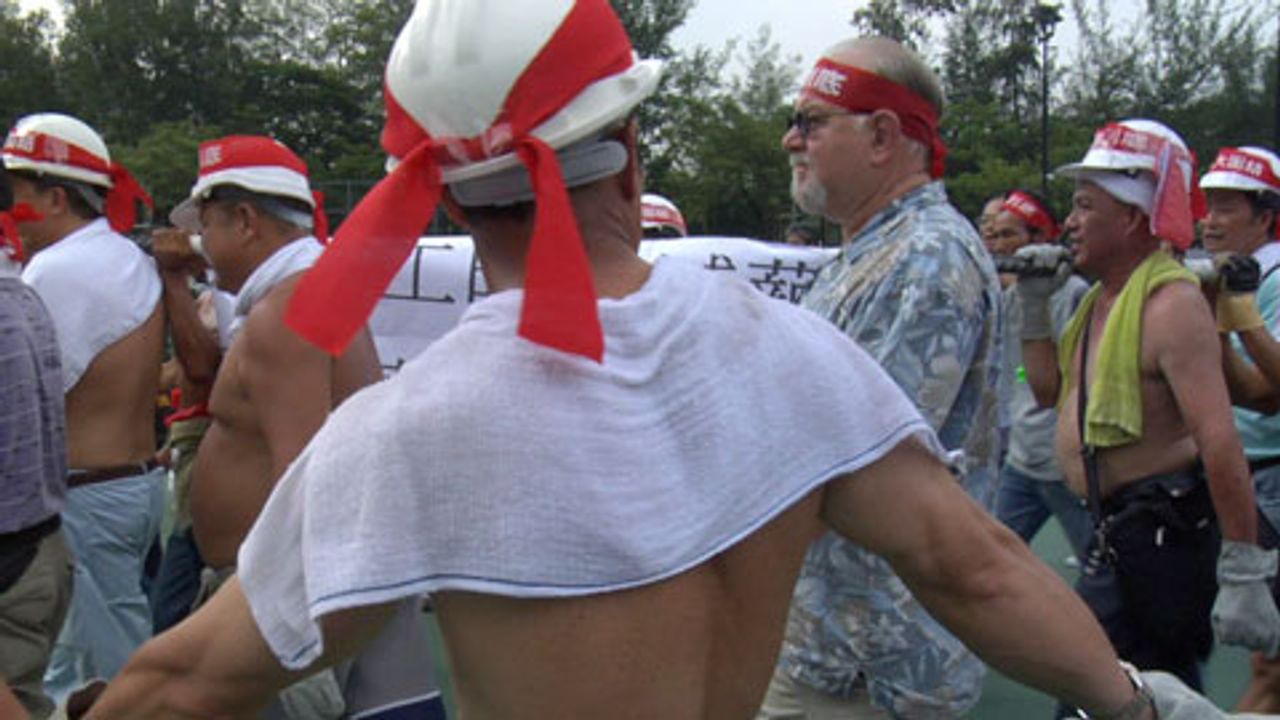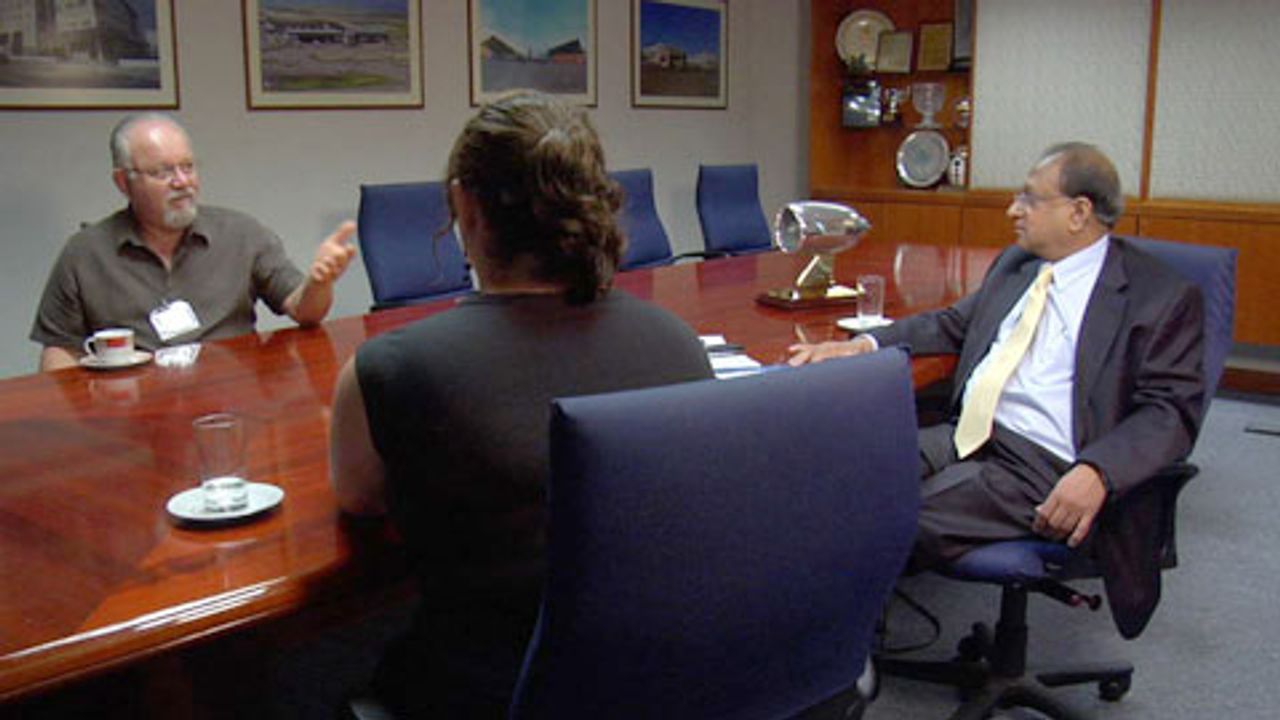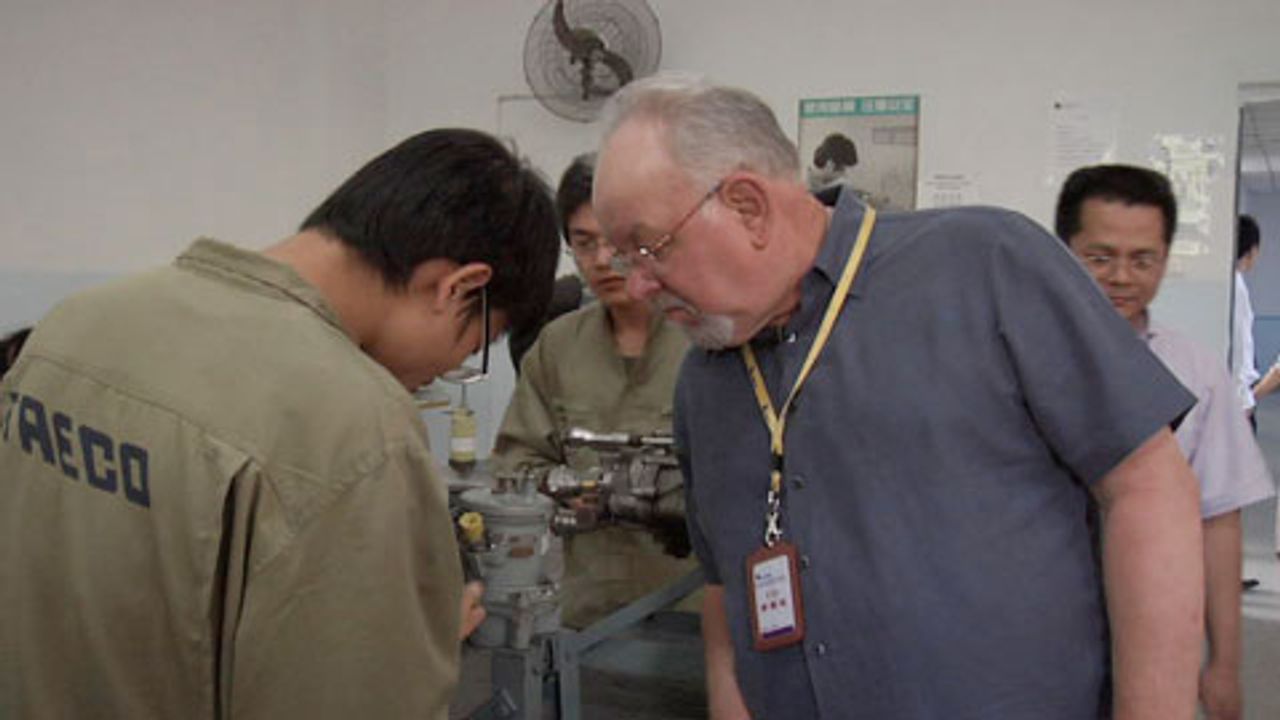The Red Tail, a documentary co-directed by Dawn Mikkelson and Melissa Koch, treats a question of immense importance: the consequences of a globally-integrated economy and the efforts by workers to defend their interests in the new conditions.
 Roy Koch marching with striking Hong Kong iron workers
Roy Koch marching with striking Hong Kong iron workersIn August 2005, some 4,400 Northwest Airline mechanics walked out on strike against the company’s demands for a massive wage cut and the elimination of more than half their jobs.
In the end, the 444-day conflict resulted in more than 4,000 of the workers—members of the independent Aircraft Mechanics Fraternal Association (AMFA)—losing their jobs, as two AFL-CIO-affiliated unions and another independent union, representing the pilots, mechanics and flight attendants at Northwest, respectively, ordered their members to cross picket lines in defiance of the most elementary principles of working class solidarity. The Teamsters, belonging to the “Change to Win” faction of the US union movement, refused to halt deliveries to the airline.
Melissa Koch, the daughter of a striking mechanic, began filming the conflict which was having such a devastating impact on her family. On the picket line in Minneapolis, she linked up with filmmaker Dawn Mikkelson. The documentarian had become involved in covering the strike after being contacted by Beth Wilson, a NWA flight attendant, who quit her job rather than cross the picket line.
Mikkelson and Koch ultimately collaborated on the production of The Red Tail, which begins as a chronicle of the bitter strike at Northwest and then proceeds to follow striking mechanic Roy Koch, Melissa’s father, as he sets out to find his outsourced job—first in Hong Kong and then China.
This is an intriguing and moving story, about an American worker and his family who seek out their Asian counterparts, and, in the process, come up against the harsh realities of global capitalism. During the course of the film, Roy and Melissa are awakened to the fact that the working population of all countries forms one international body.
The Red Tail touches on the 1997-98 decision by mechanics at Northwest to leave the International Association of Machinist (IAM), an affiliate of the AFL-CIO, and join AMFA. The systematic scabbing by the AFL-CIO and other unions against the 2005 Northwest strike was more, however, than simply an act of revenge. It was an expression of the union hierarchy’s ferocious hostility to any action by workers that could have sparked a movement against wage-cutting and concessions.
The mechanics’ strike went down to defeat in the face of the combined efforts of a giant corporation and the so-called labor movement, with the support of the Bush administration and the media.
Northwest viewed the crushing of its mechanics as one component of an overall program of downsizing and cost-cutting, whose implementation has not stopped to the present moment.
Remarkably, in August 2006, as the WSWS noted at the time, the airline sent a handbook to soon-to-be-terminated employees on how to manage their unemployed state. The booklet included tips on thrift store shopping and not being “shy about pulling something you like out of the trash.” This, to employees who had decades of service for the airline. The flying public was not left unscathed. Northwest coined the term “normal emergency landing,” which was a back-handed way of admitting that emergency landings increased dramatically during the strike.
The Red Tail points out that between 9/11 and the mechanics’ walkout, the airline laid off some 5,000 workers. (One month after the strike began, Northwest declared bankruptcy, citing $3.5 billion in losses since 2001. An April 2006 report in Forbes Magazine disclosed that Douglas Steenland, the airline’s president and CEO, was pulling in nearly $1.5 million per year. In April 2008, in a deal that would create the world’s largest airline, the executive boards of Delta and Northwest announced their intention to merge.)
The most unusual and compelling aspect of the documentary’s story unfolds after the defeat of the mechanics’ strike.
In August 2007, the Koch family travels to Hong Kong “to meet the worker who took Roy’s job.” At this point, Melissa is attempting to help reenergize her father, who at age 58 has lost a career he pursued for 28 years. Now working as a cook, Roy’s income is a fraction of what it would have been with full retirement benefits.
Soon after landing in Hong Kong, Roy marches with demonstrating ironworkers who are waging one of the largest strikes in Hong Kong history. He shows the workers his “honorary withdrawal” AMFA card, a recognition of his refusal to scab.
 Roy Koch and Melissa Koch at Hong Kong Aircraft Engineering Company (HAECO) with Ashok Sathianathan, CEO of HAECO
Roy Koch and Melissa Koch at Hong Kong Aircraft Engineering Company (HAECO) with Ashok Sathianathan, CEO of HAECOTo guard against victimization, Roy meets his “replacement” at the Hong Kong Aircraft Engineering Company (HAECO) off camera. HAECO is one of the major maintenance bases serving Northwest, United and Delta, among others. But, even as Roy is meeting the Hong Kong mechanic, the latter learns his job is being outsourced to mainland China.
Nine months later, Roy and Melissa undertake another journey, this time to Xiamen, China, for an encounter with executives from HAECO’s sister company TAECO, now in the throes of preparing its own move to cheaper labor markets.
In Xiamen, Roy and Melissa sneak past guards and enter the complex where TAECO houses its workforce. The film team is again careful not to show the faces of the Chinese workers. “Yellow unions,” explains the documentary, are part of the government and therefore prohibited from striking. Although airline mechanics are highly skilled in China, wages are a mere $300 month.
 Roy Koch at Taikoo Aircraft Engineering Company (TAECO) training facility in Xiamen, China
Roy Koch at Taikoo Aircraft Engineering Company (TAECO) training facility in Xiamen, ChinaHow could one not be moved by the family’s efforts? And by what they discover? They see for themselves that workers in Hong Kong and China are just like them, striving to live decently in the face of the employers’ ruthless drive for profit. The breaking down of national and parochial barriers, the recognition of the commonality of workers’ interests is not a small matter. Says Melissa, towards the film’s end, with considerable emotion and sincerity, “I’ve experienced the possibility of global solidarity.”
The Red Tail demonstrates that workers are driven objectively to go beyond the narrow national framework policed by the union apparatuses and the political powers that be. This is affectingly, humanly, palpably proven by the Mikkelson-Koch documentary.
At the same time, however, the film perhaps raises more questions than it answers. In and of itself, that is not even a criticism. Raising questions is all to the good. But, at a certain point, filmmakers too have to draw some conclusions, even harsh ones, and that is more challenging for most artists at the moment.
One of the difficulties is the confusion, almost nostalgia in some cases, that still exists about the trade unions. A good number of well-intentioned individuals in the arts, whose experience of working class life may be limited, continue to identify the unions with the working class and working class struggle. This is a prejudice that needs to be overcome if the more profound truths about American life are to be addressed.
It is significant that the filmmakers and the Koch family responded to the power and potential of the global working population. But it is also necessary to consider the other side of the equation: the organizations that quite consciously work against the international unification of workers in the interests of the ruling elites everywhere, the national trade unions and their apologists. One has to state the truth: the AFL-CIO is no more representative of its membership than the Chinese state-run trade unions. The American unions are bureaucratic shells in which workers find themselves trapped.
Interestingly, the filmmakers include a clip from the Charlie Rose interview program in June 2007 in which “Change to Win” union leader Andy Stern talks about the need for “global unions,” describing his role in helping to officially organize Wal-Mart workers in China. (In June 2010, it is worth noting, Stern joined the board of directors of SIGA, a company that specializes in biological warfare defense.) His version of “global unionism” chillingly brings to mind the AFL-CIO’s American Institute for Free Labor Development. Through decades of collaboration with the US government, the AIFLD became known internationally as the CIA’s “labor front,” dedicated to subverting militant unions and provoking “labor” unrest against governments targeted by Washington.
Moreover, perhaps inadvertently, The Red Tail reveals as well that break-away, “independent” unions, such as AMFA, are no more capable of advancing the struggles of the working class than the AFL-CIO bureaucracy. The AMFA leadership, while more honest and not composed of hardened traitors, because of its lack of political and social perspective, saw the strike at Northwest in narrow terms, and never considered turning toward wide layers of the population in the struggle against concessions and layoffs.
At one point, in The Red Tail, AMFA Local 33’s Ted Ludwig says it is necessary to “fight back even if you don’t win.” The notion of heroic but inevitably lost causes is a bad one. The international working class is tremendously powerful and can certainly “win”—to do that, however, it has to assert its own independent social and political interests.
The film’s talking heads, such as Congressman Jim Oberstar of the Democratic-Farmer-Labor Party—the Democratic Party in Minnesota—and academic Peter Rachleff, deliver routine pronouncements and don’t offer an alternative to the political-corporate onslaught against jobs and wages.
It is not the job of filmmakers to work out all the complex political problems of our time, but if they are going to approach the latter, they will inevitably be held to a high standard. Because, to their credit, Mikkelson and Koch have raised big issues, one feels as well the serious limitations. One is more demanding of those who are working toward something important; in this case, presenting to audiences the extraordinary human drama produced by the conditions of modern economic life. The Red Tail allows us to encounter a remarkable worker passing through remarkable experiences.
